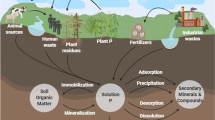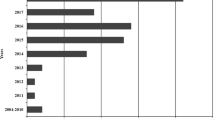Abstract
Debris from aquatic macrophytes and algae are important recycling sources of phosphorus (P), which can result in continuing blooms of algae by recycling bioavailable P in the eutrophic lakes. However, knowledge of forms of P in aquatic macrophytes and algae and their contribution to internal loads of P in lakes is limited. Without such knowledge, it is difficult to develop appropriate strategies to remediate and or restore aquatic ecosystems that have become eutrophic. Therefore, in this work, P was extracted from six types of aquatic macrophytes and algae collected from Tai Lake of China and characterized by use of solution 31P-nuclear magnetic resonance (NMR) spectroscopy. When extracted by 0.5 M NaOH-25 mM EDTA, extraction recovery of total P(TP) and organic P(Po) exceeded 90 %. Concentrations of Po in algae and aquatic macrophytes were 5552 mg kg−1 and 1005 mg kg−1 and accounted for 56.0 and 47.2 % of TP, respectively. When Po, including condensed P, was characterized by solution 31P-NMR Po in algae included orthophosphate monoesters (79.8 %), pyrophosphate (18.2 %), and orthophosphate diester (2.0 %), and Po in aquatic macrophytes included orthophosphate monoesters (90.3 %), pyrophosphate (4.2 %), and orthophosphate diester (5.5 %). Additionally, orthophosphate monoesters in algal debris mainly included β-glycerophosphate (44.1 %), α-glycerophosphate (13.5 %), and glucose 6-phosphate (13.5 %). Orthophosphate monoesters in aquatic macrophytes mainly included β-glycerophosphate (27.9 %), α-glycerophosphate (24.6 %), and adenosine 5′ monophosphate (8.2 %). Results derived from this study will be useful in better understanding nutrient cycling, relevant eutrophication processes, and pollution control for freshwater lakes.



Similar content being viewed by others
References
Ahlgren JK, Reitzel R, Danielsson A et al (2006) Biogenic phosphorus in oligotrophic mountain lake sediments: differences in composition measured with NMR spectroscopy. Water Res 40:3705–3712
Atkinson M, Smith S (1983) C: N: P ratios of benthic marine plants. Limnol Oceanogr 28:568–574
Bai X, Ding S, Fan C et al (2009) Organic phosphorus species in surface sediments of a large, shallow, eutrophic lake, Lake Taihu, China. Environ Pollut 157:2507–2513
Baldwin DS (2013) Organic phosphorus in the aquatic environment. Environ Chem 10:439–454
Cade-Menun BJ, Liu C, Nunlist R et al (2002) Soil and litter phosphorus-31 nuclear magnetic resonance spectroscopy. J Environ Qual 31:457–465
Cade-Menun BJ (2005) Characterizing phosphorus in environmental and agricultural samples by 31 P nuclear magnetic resonance spectroscopy. Talanta 66:359–371
Cade-Menun, B. J. 2015. Improved peak identification in 31 P-NMR spectra of environmental samples with a standardized method and peak library. Geoderma.
Cade-Menun BJ, He Z, Zhang H et al (2015) Stratification of phosphorus forms from long-term conservation tillage and poultry litter application. Soil Sci Soc Am J 79:504–515
Cembella AD, Antia NJ, Harrison PJ (1982) The utilization of inorganic and organic phosphorous compounds as nutrients by eukaryotic microalgae: a multidisciplinary perspective: part I. Crit Rev Microbiol 10:317–391
Da-Peng L, Yong H (2010) Sedimentary phosphorus fractions and bioavailability as influenced by repeated sediment resuspension. Ecol Eng 36:958–962
Doolette A, Smernik R, Dougherty W (2009) Spiking improved solution phosphorus-31 nuclear magnetic resonance identification of soil phosphorus compounds. Soil Sci Soc Am J 73:919--927
Giles CD et al (2015) Characterization of organic phosphorus form and bioavailability in lake sediments using P nuclear magnetic resonance and enzymatic hydrolysis. J Environ Qual 44:882–894
He Z, Cade-MenunB J, Toor GS et al (2007) Comparison of phosphorus forms in wet and dried animal manures by solution phosphorus-31 nuclear magnetic resonance spectroscopy and enzymatic hydrolysis. J Environ Qual 36:1086–1095
He Z, Honeycutt CW, Griffin TS et al (2009) Phosphorus forms in conventional and organic dairy manure identified by solution and solid state P-31 NMR spectroscopy. J Environ Qual 38:1909–1918
He Z, Olk DC, Cade-Menun BJ (2011) Forms and lability of phosphorus in humic acid fractions of Hord silt loam soil. Soil Sci Soc Am J 75:1712–1722
Heath RT (2005) Microbial turnover of organic phosphorus in aquatic systems. Organic phosphorus in the environment. CABI, Wallingford, pp 185–204
Lorenz K, Preston CM, Krumrei S et al (2004) Decomposition of needle/leaf litter from Scots pine, black cherry, common oak and European beech at a conurbation forest site. Eur J For Res 123:177–188
Makarov M, Haumaier L, Zech W (2002) Nature of soil organic phosphorus: an assessment of peak assignments in the diester region of 31 P NMR spectra. Soil Biol Biochem 34:1467–1477
Meyers PA, Ishiwatari R (1993) Lacustrine organic geochemistry—an overview of indicators of organic matter sources and diagenesis in lake sediments. Org Geochem 20:867–900
Monbet P, Mckelvie ID, Worsfold PJ (2009) Dissolved organic phosphorus speciation in the waters of the Tamar estuary (SW England). Geochim Cosmochim Acta 73:1027–1038
Murphy J, Riley JP (1962) A modified single solution method for the determination of phosphate in natural waters. Anal Chim Acta 27:31–36
Newman R, Tate K (1980) Soil phosphorus characterisation by 31P nuclear magnetic resonance. Communications in Soil Science & Plant Analysis 11:835–842
Noack SR, Smernik RJ, Mcbeath TM et al (2014) Assessing crop residue phosphorus speciation using chemical fractionation and solution 31 P nuclear magnetic resonance spectroscopy. Talanta 126:122–129
Otten T, Xu H, Qin B, Zhu G et al (2012) Spatiotemporal patterns and ecophysiology of toxigenic microcystis blooms in Lake Taihu, China: implications for water quality management. Environ Sci Technol 46:3480–3488
Paerl HW, Xu H, Mccarthy MJ et al (2011) Controlling harmful cyanobacterial blooms in a hyper-eutrophic lake (Lake Taihu, China): the need for a dual nutrient (N & P) management strategy. Water Res 45:1973–1983
Pinchuk GE, Ammons C, Culley DE et al (2008) Utilization of DNA as a sole source of phosphorus, carbon, and energy by Shewanella spp.: ecological and physiological implications for dissimilatory metal reduction. Appl Environ Microbiol 74:1198–1208
Qu X, Xie L, Lin Y et al (2013) Quantitative and qualitative characteristics of dissolved organic matter from eight dominant aquatic macrophytes in Lake Dianchi, China. Environ Sci Pollut Res 20:7413–7423
Read EK, Ivancic M, Hanson P et al (2014) Phosphorus speciation in a eutrophic lake by 31 P NMR spectroscopy. Water Res 62:229–240
Redfield A, Ketchum B, Richards F (1963) The influence of organisms on the composition of sea water. In: The Sea; ideas and observations, 2. Interscience Publishers, NY, pp 26–77
Reitzel K, Ahlgren J, Gogoll A et al (2006) Effects of aluminum treatment on phosphorus, carbon, and nitrogen distribution in lake sediment: a 31 P NMR study. Water Res 40:647–654
Ruban V, Brigault S, Demare D et al (1999) An investigation of the origin and mobility of phosphorus in freshwater sediments from Bort-Les-Orgues Reservoir, France. J Environ Monit 1:403–407
Søndergaard M, Jensen JP, Jeppesen E (2003) Role of sediment and internal loading of phosphorus in shallow lakes. Hydrobiologia 506:135–145
Smith VH, Tilman GD, Nekola JC (1999) Eutrophication: impacts of excess nutrient inputs on freshwater, marine, and terrestrial ecosystems. Environ Pollut 100:179–196
Tao Y, Yuan Z, Fengchang W, Wei M (2013) Six-decade change in water chemistry of large freshwater Lake Taihu, China. Environ Sci Technol 47:9093–9101
Turner BL, Cheesman AW, Godage HY et al (2012) Determination of neo-and D-chiro-inositol hexakisphosphate in soils by solution 31P NMR spectroscopy. Environ Sci Technol 46:4994–5002
Turner BL, Richardson AE (2004) Identification of inositol phosphates in soil by solution phosphorus-31 nuclear magnetic resonance spectroscopy. Soil Sci Soc Am J 68:802–808
Turner BL, Mahieu N, Condron LM (2003) Phosphorus-31 nuclear magnetic resonance spectral assignments of phosphorus compounds in soil NaOH–EDTA extracts. Soil Sci Soc Am J 67:497–510
Wang J, Pant HK (2010) Identification of organic phosphorus compounds in the Bronx River bed sediments by phosphorus-31 nuclear magnetic resonance spectroscopy. Environ Monit Assess 171:309–319
Ye C, Shen Z, Zhang T et al (2011) Long-term joint effect of nutrients and temperature increase on algal growth in Lake Taihu, China. J Environ Sci 23:222–227
Zhang W, Tang W, Zhang H et al (2014) Characterization of biogenic phosphorus in sediments from the multi-polluted Haihe River, China, using phosphorus fractionation and 31 P-NMR. Ecol Eng 71:520–526
Zhong W, Zhang Z, Luo Y et al (2012) Biogas productivity by co-digesting Taihu blue algae with corn straw as an external carbon source. Bioresour Technol 114:281–286
Zhou Q, Gibson CE, Zhu Y (2001) Evaluation of phosphorus bioavailability in sediments of three contrasting lakes in China and the UK. Chemosphere 42:221–225
Zhu Y, Wu F, He Z (2015) Influence of natural organic matter on the bioavailability and preservation of organic phosphorus in lake sediments. Chem Geol 397:51–60
Zhu Y, Wu F, He Z et al (2013a) Characterization of organic phosphorus in lake sediments by sequential fractionation and enzymatic hydrolysis. Environ Sci Technol 47:7679–7687
Zhu Y, Zhang R, Wu F et al (2013b) Phosphorus fractions and bioavailability in relation to particle size characteristics in sediments from Lake Hongfeng, Southwest China. Environmental earth sciences 68:1041–1052
Acknowledgments
This present study was supported in part by the National Natural Science Foundation of China (41403094, 41403743, 41261140337). Prof. Giesy was supported by the Canada Research Chair program, the Einstein Professor Program of the Chinese Academy of Sciences, and the Great-Tier Foreign Scholar program (#GDT20143200016), funded by the State Administration of Foreign Experts Affairs, the P. R. China to Nanjing University.
Author information
Authors and Affiliations
Corresponding authors
Additional information
Responsible editor: Philippe Garrigues
Rights and permissions
About this article
Cite this article
Feng, W., Zhu, Y., Wu, F. et al. Characterization of phosphorus forms in lake macrophytes and algae by solution 31P nuclear magnetic resonance spectroscopy. Environ Sci Pollut Res 23, 7288–7297 (2016). https://doi.org/10.1007/s11356-015-5913-5
Received:
Accepted:
Published:
Issue Date:
DOI: https://doi.org/10.1007/s11356-015-5913-5




